 When the brick or stone walls on a building move you have no choice but to install masonry repair anchors to hold the wall back. It may be prudent to discuss your situation with Handy Home Pro to see if your problem has the potential of being stabilized by the use of masonry repair anchors. It just may save you some hard earned cash.
When the brick or stone walls on a building move you have no choice but to install masonry repair anchors to hold the wall back. It may be prudent to discuss your situation with Handy Home Pro to see if your problem has the potential of being stabilized by the use of masonry repair anchors. It just may save you some hard earned cash.
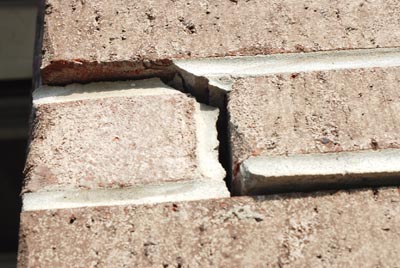
Usually you will find the brick or stone offset from the original wall plane indicating that the wall is beginning to move outward. This is a sure sign that some masonry repair anchors are needed within the wall system to stabilize its’ position and prevent further creeping.
Masonry Repair Anchors might offer you an alternative to rebuilding or underpinning…
After determining that a ‘wall stabilization anchoring system’ is a practical solution for the stabilization of masonry movement then the placement locations of the anchors are determined.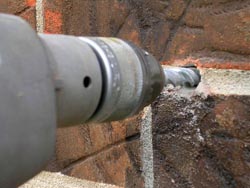 This varies form wall to wall depending on how severe the problem is and how many anchors will be needed in order to handle the ‘load’ placed upon the newly installed anchors. Generally speaking the anchors will be placed between 16″ and 32″ on both the horizontal and vertical plane.
This varies form wall to wall depending on how severe the problem is and how many anchors will be needed in order to handle the ‘load’ placed upon the newly installed anchors. Generally speaking the anchors will be placed between 16″ and 32″ on both the horizontal and vertical plane.
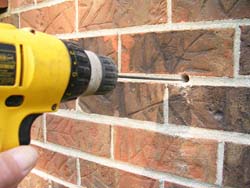 Pilot holes are drilled to access the backing of the wall system which will either be framing or ‘backup’ masonry. On most buildings the structure is framing. So a second pilot hole is drilled through the first pilot hole in the masonry in order to locate the back up framing.
Pilot holes are drilled to access the backing of the wall system which will either be framing or ‘backup’ masonry. On most buildings the structure is framing. So a second pilot hole is drilled through the first pilot hole in the masonry in order to locate the back up framing.
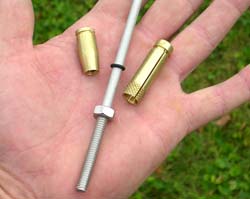
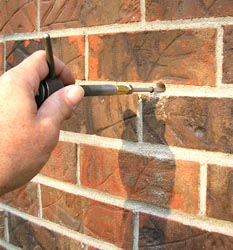 This secondary pilot hole then ‘guides’ the anchor into the appropriate placement within the framing to assure a good ‘bite’ into the framing studs.
This secondary pilot hole then ‘guides’ the anchor into the appropriate placement within the framing to assure a good ‘bite’ into the framing studs.
Masonry Repair Anchors require a thorough and methodical step by step process.
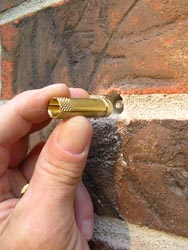
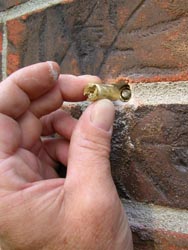 Next we install the anchor into the framing. This is done by inserting the anchor thru the hole in the masonry and into the pilot or guide hole we drilled into the framing.
Next we install the anchor into the framing. This is done by inserting the anchor thru the hole in the masonry and into the pilot or guide hole we drilled into the framing.
A special tool is provided by the anchor manufacture to ‘screw’ the anchor into the framing far enough to hide the the anchor behind the face of the masonry.
Once the anchor has been screwed into place into the framing then the anchor sleeve and furrel are installed.
The quality of the masonry repair anchor is critical to a successful anchoring process.
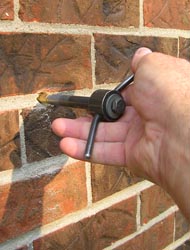
The sleeve and furrels are made of brass to prevent corrosion. The sleeve provides the necessary grip to hold the anchor to the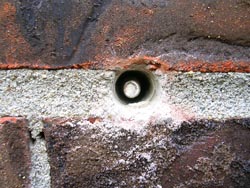 masonry.
masonry.
The furrel is placed into the sleeve and tightened. As the furrel is tightened it expands the sleeve against the masonry and since brass is soft, it deforms providing excellent surface area for gripping the masonry wall.
Once installed these anchors will last the lifetime of the building.
The final process it to tuck point the holes drilled into the masonry to close of the wall system and 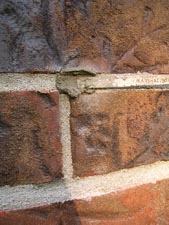 prevent water infiltration. In addition any cracks caused by the building movement will be tuck pointed.
prevent water infiltration. In addition any cracks caused by the building movement will be tuck pointed.
Contact us for a quote or more info.























